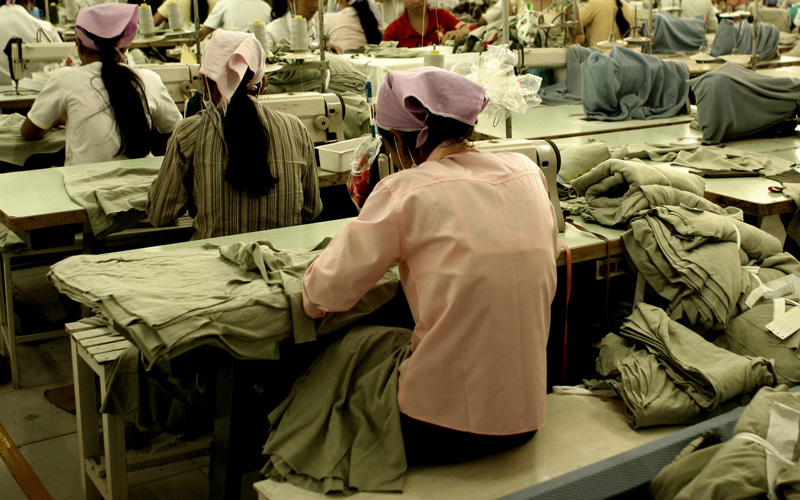
by guest blogger Marci Zaroff, ecofashion pioneer, founder of Under the Canopy, and president of Portico Brands
“Be the change you wish to see in the world.” —Gandhi
Over the past two decades, I’ve been on an eye-opening journey. Pulling the curtain back on the fashion industry, I’ve uncovered that it’s the second largest polluter in the world. According to the Textile Exchange, fashion and textiles account for 10 percent of the world’s global carbon impact—using more than a trillion kilowatt hours of energy annually—and occupy more than 5 percent of landfill waste. The fashion and textile industry also uses 3 trillion gallons of freshwater, accounting for 20 percent of freshwater pollution.
Today, we consume 400 percent more clothing than we did two decades ago. Many of the 40 million world’s garment-factory workers make less than $1 a day. Mass-market fashion retailers are outsourcing more than 97 percent of their apparel production to unstable developing countries, where environments—and lives—are being exploited.
Given these factors, it’s no longer a choice, but rather, an imperative, that we shift the “faster, cheaper, more” mentality pervasive in fashion houses and held by consumers toward a more sustainable and slower model for fashion—one that measures the “True Cost” to people and the planet instead of defining success solely by bottom line profits or ownership of a new disposable outfit every day.
We can no longer operate with “fashion business as usual.”
Fortunately, there are a myriad of innovations and collaborations taking root, demonstrating that collective action can drive positive change. Below is some food for thought: three key ways you can vote with your dollars.
1. Organic food to fiber. A recent study by the Textile Exchange shows that “organic cotton is proven to cause less environmental damage than conventional cotton,” with a significant reduction in global warming potential, soil erosion, water use, and energy demand. With 84 percent of American consumers now eating organic food at least occasionally, the seed of consciousness has been planted. While conventional cotton represents less than 3 percent of the world’s agriculture, growing it can use up to 25 percent of the world’s most harmful insecticides and 10 percent of the most carcinogenic pesticides. Because the plant is interconnected in agriculture and 60 percent of the cotton plant goes into the food stream as feed and oil, as with organic food, organic cotton is free of GMOs and toxic chemicals—and so is the next frontier in an organic lifestyle. From farm to finished fashion, organic apparel and home textiles offer no compromise in style or substance for today’s conscious consumer. You can find modern design and high-quality organic fashion that’s affordable, authentic, and accessible, while adding values to value. Look for fully traceable Global Organic Textile Standard (GOTS)–certified organic products, and join the movement and solution—for a green, chic, and healthy planet.
2. Fair trade and community. The Rana Plaza collapse in Bangladesh in 2013, which killed more than 1,133 innocent garment workers, was a worldwide wake-up call, shedding light on dangerous working conditions and slave-labor wages in mass apparel production. Our clothing is not made in the fast-fashion store; people’s lives and communities are being deeply affected globally. In addition to the GOTS social standards of fair working conditions and no child labor, this past year, Fair Trade USA also launched the first Fair Trade textile certification, guaranteeing living wages to those growing and sewing our garments. Further, global citizens have banded together in a powerful consumer-driven Fashion Revolution, now asking the question: “Who made my clothes?” Buy Fair Trade, and elect to respect and protect our fellow humanity.
3. Full circle. With the reuse, recycling, and repurposing of clothing, vintage shops are becoming more readily available, and craftsmanship in garmenting is making a comeback. Apparel recycling bins are popping up in front of stores and malls in cities nationwide. Exciting fashion incubators, such as the Brooklyn Fashion & Design Accelerator, are empowering young designers to design using sustainable materials and ethical manufacturing methods. The Cradle-to-Cradle (C2C) Innovation Institute recently released its “Fashion Positive” certification, measuring material health, material reuse, renewable energy, water stewardship, and social fairness. Seek C2C-certified garments; buy quality, not quantity; support RPET—a groundbreaking fiber/fabric made from recycled plastic bottles taken out of landfills. Recognize our symbiotic relationship with the planet and the wisdom of nature. Our Earth’s resources are limited, so share the vision for a circular economy, and make a difference today—and tomorrow.
 Marci Zaroff is an internationally recognized ecolifestyle entrepreneur, educator, innovator, and expert. As founder of Under the Canopy and Metawear, producer of “THREAD|Driving Fashion Forward,” and cofounder of The Institute for Integrative Nutrition and I AM Enlightened Creations, Marci has been instrumental in driving authenticity, environmental leadership, and social justice worldwide for more than 25 years. A board member of the Organic Trade Association, Textile Exchange, Fashion Revolution Day, Fashion Positive, and Teens Turning Green, Marci was also a key figure in the development of the Global Organic Textile Standard (GOTS) and the first Fair Trade textile certification. Marci has received countless recognitions—including New York Moves’ Power Women Award, Fashion Group International’s Rising Star Award, and the Natural Product Industry’s Socially Responsible Business Award.
Marci Zaroff is an internationally recognized ecolifestyle entrepreneur, educator, innovator, and expert. As founder of Under the Canopy and Metawear, producer of “THREAD|Driving Fashion Forward,” and cofounder of The Institute for Integrative Nutrition and I AM Enlightened Creations, Marci has been instrumental in driving authenticity, environmental leadership, and social justice worldwide for more than 25 years. A board member of the Organic Trade Association, Textile Exchange, Fashion Revolution Day, Fashion Positive, and Teens Turning Green, Marci was also a key figure in the development of the Global Organic Textile Standard (GOTS) and the first Fair Trade textile certification. Marci has received countless recognitions—including New York Moves’ Power Women Award, Fashion Group International’s Rising Star Award, and the Natural Product Industry’s Socially Responsible Business Award.




No comments yet.